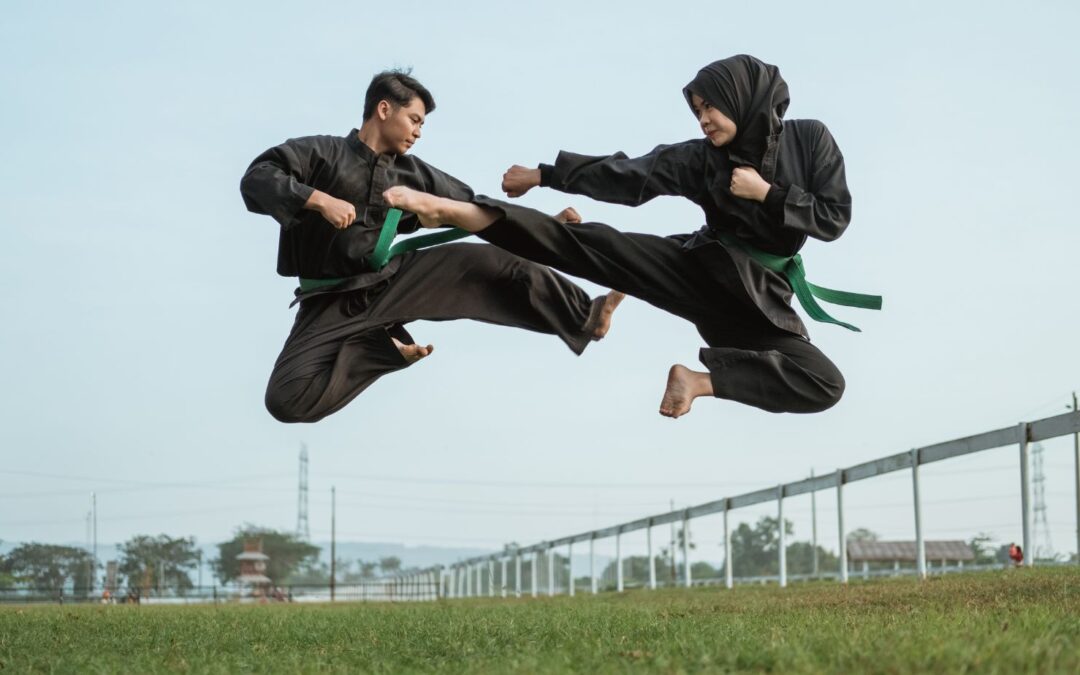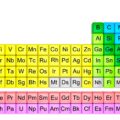In the world of martial arts, Pencak Silat holds a special place. Originating from the Southeast Asian archipelago, it’s more than just a fighting technique; it’s a dance, a cultural expression, and a way of life. But what about the arena where this art form unfolds? How large is a Pencak Silat arena, or “gelanggang”?
The dimensions of the “gelanggang” are a crucial aspect of Pencak Silat, affecting the flow of the game and the strategies employed by the fighters. Let’s delve into the specifics of the Pencak Silat arena, its size, and how it impacts the dynamics of this fascinating martial art.
Ukuran Gelanggang Pencak Silat Adalah
Delving deeper into the world of Pencak Silat, it’s instrumental to first understand its origin and vast popularity, then discuss the game’s basic rules and regulations.
Origins and Popularity of Pencak Silat
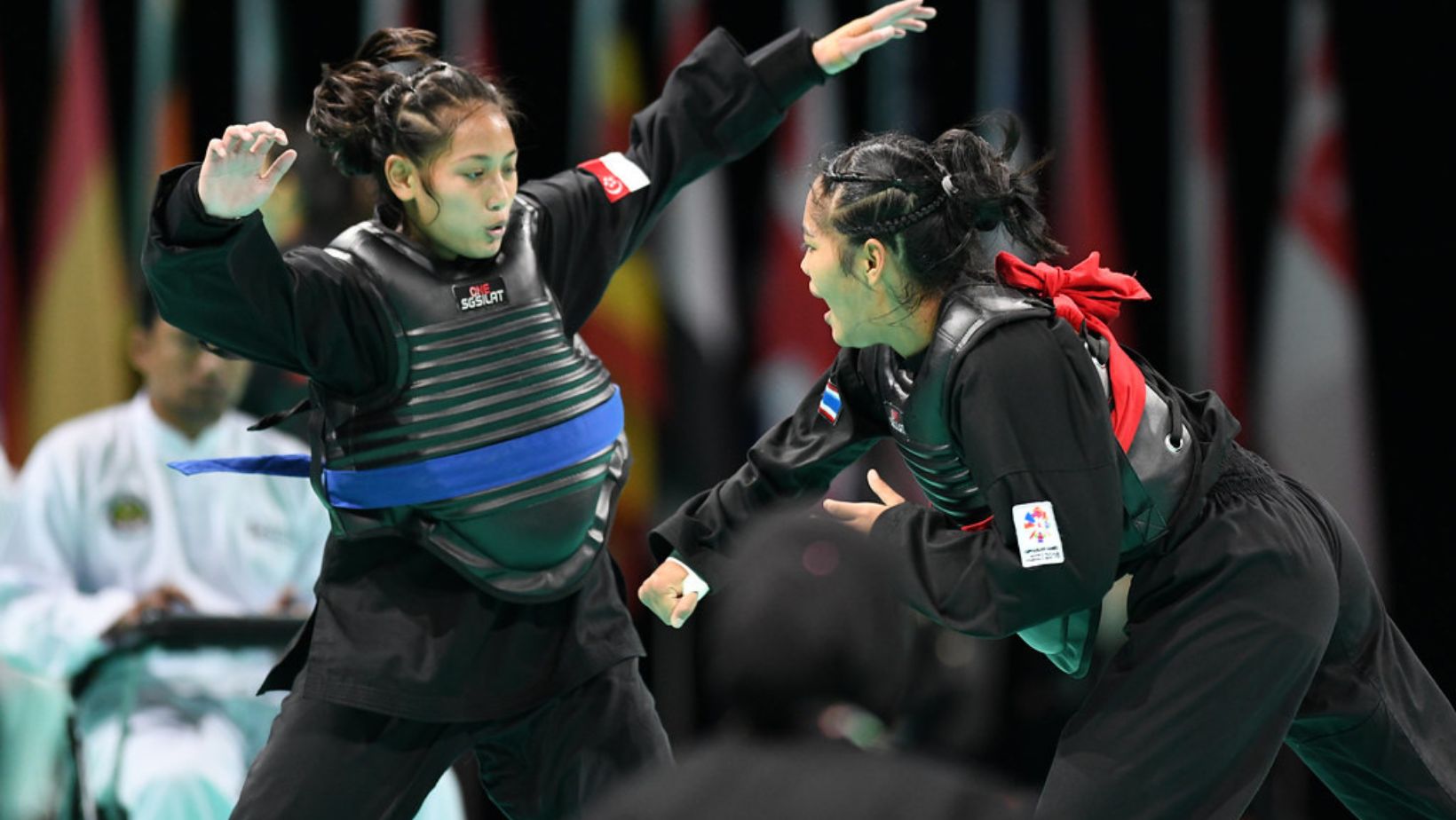 Pencak Silat originated in the geographic intersection of several Southeast Asian countries. Notably, Indonesia, Malaysia, Southern Thailand, and Singapore bear the rich historical imprint of this martial art form. Showcased not merely as a combat technique, Pencak Silat is revered as an embodiment of dance, sport, and a facet of cultural identity. Augmented by compelling rhythmic movements and mesmerizing techniques, the sport’s popularity spreads far and wide, crossing the regional borders and fascinating enthusiasts globally.
Pencak Silat originated in the geographic intersection of several Southeast Asian countries. Notably, Indonesia, Malaysia, Southern Thailand, and Singapore bear the rich historical imprint of this martial art form. Showcased not merely as a combat technique, Pencak Silat is revered as an embodiment of dance, sport, and a facet of cultural identity. Augmented by compelling rhythmic movements and mesmerizing techniques, the sport’s popularity spreads far and wide, crossing the regional borders and fascinating enthusiasts globally.
Maintaining an ever-increasing footprint, Pencak Silat has participants from various countries worldwide, exhibiting differing styles and techniques inherent in their regions. Keen international interest manifest in events like the World Pencak Silat Championship testifies to its expanding appeal.
Basic Rules and Regulations of Pencak Silat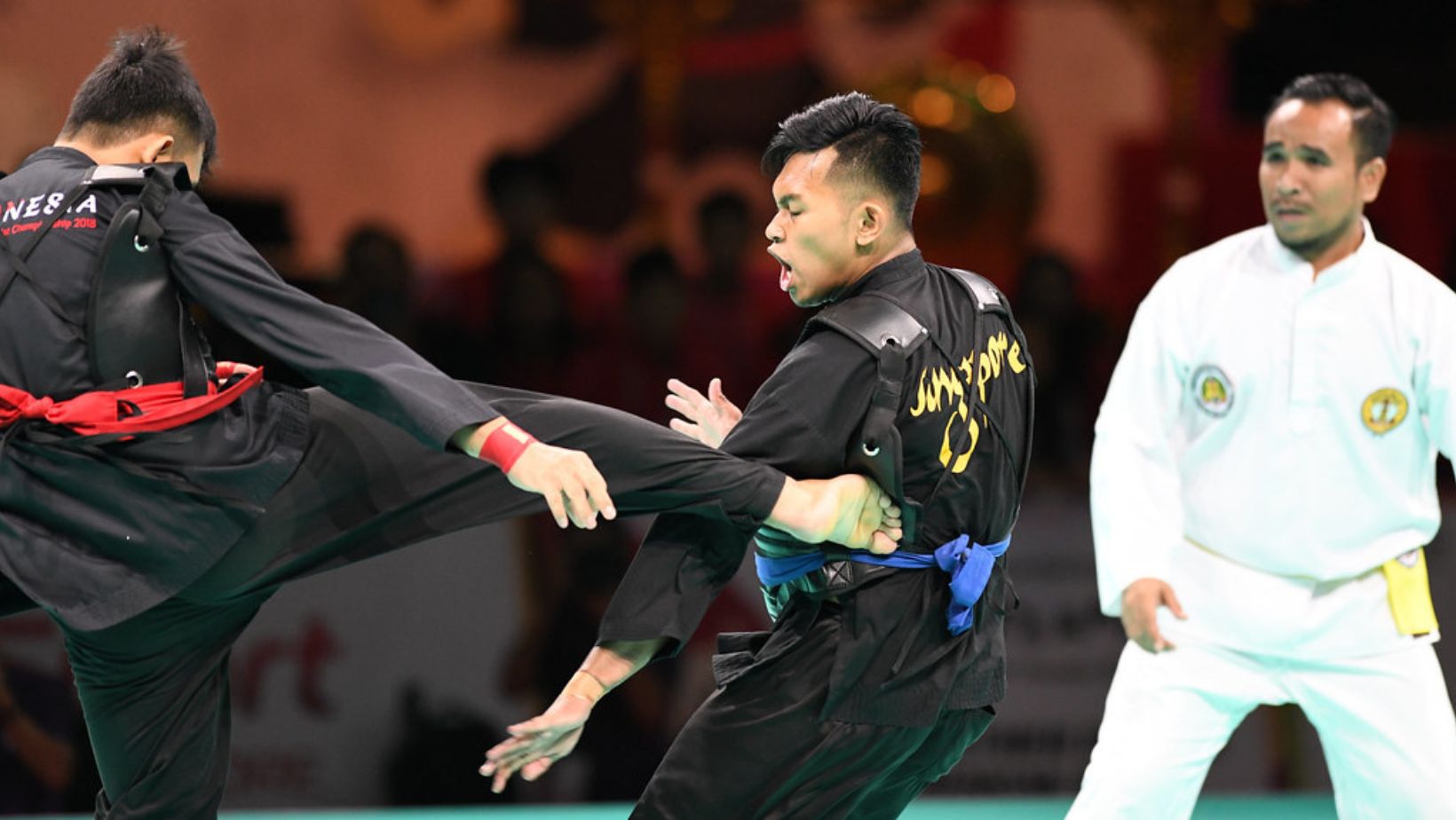
To appreciate Ukuran Gelanggang Pencak Silat Adalah, comprehension of its basic rules is fundamental. Centering on one-on-one combat, the game commands two players, ‘pesilats,’ to step into a ring known as the ‘gelanggang.’ Adapting to strict dimensions of 8 by 8 meters, the gelanggang serves a vital role in dictating the game flow and shaping the competitor’s strategies.
Success is attained by landing valid blows on the opponent, with varying points for hits on specific regions of the body. Pesilats earn the highest score of three 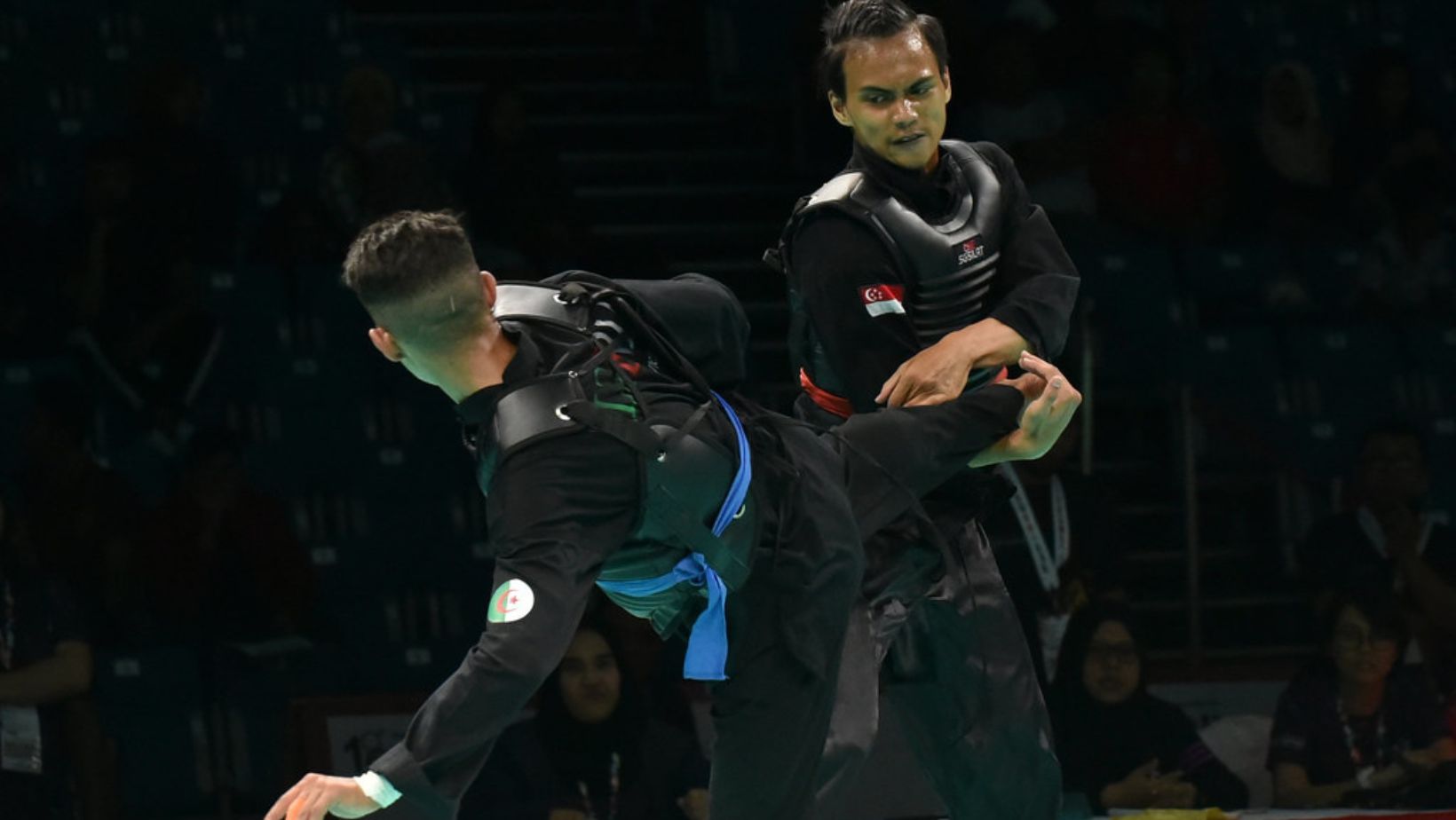 points for assertive strikes on the chest or back. Actions involving ‘sweeping’ the opponent off their feet, and strikes at limbs garner, respectively, two and one points. Strict enforcement of rules, such as a minimum of guarding posture and ‘attacking’ movements, further adds nuanced layers to this martial art form.
points for assertive strikes on the chest or back. Actions involving ‘sweeping’ the opponent off their feet, and strikes at limbs garner, respectively, two and one points. Strict enforcement of rules, such as a minimum of guarding posture and ‘attacking’ movements, further adds nuanced layers to this martial art form.
Elucidating these rules highlights how Pencak Silat extends beyond martial artistry into a strategic game, where the skillful manipulation of the gelanggang is as crucial as mastering self-defense tactics. Indeed, the tapestry of Pencak Silat, woven from its ancient origins and regulated movements, presents a fascinating narrative much like the varied paths its practitioners follow.
Understanding the Pencak Silat Arena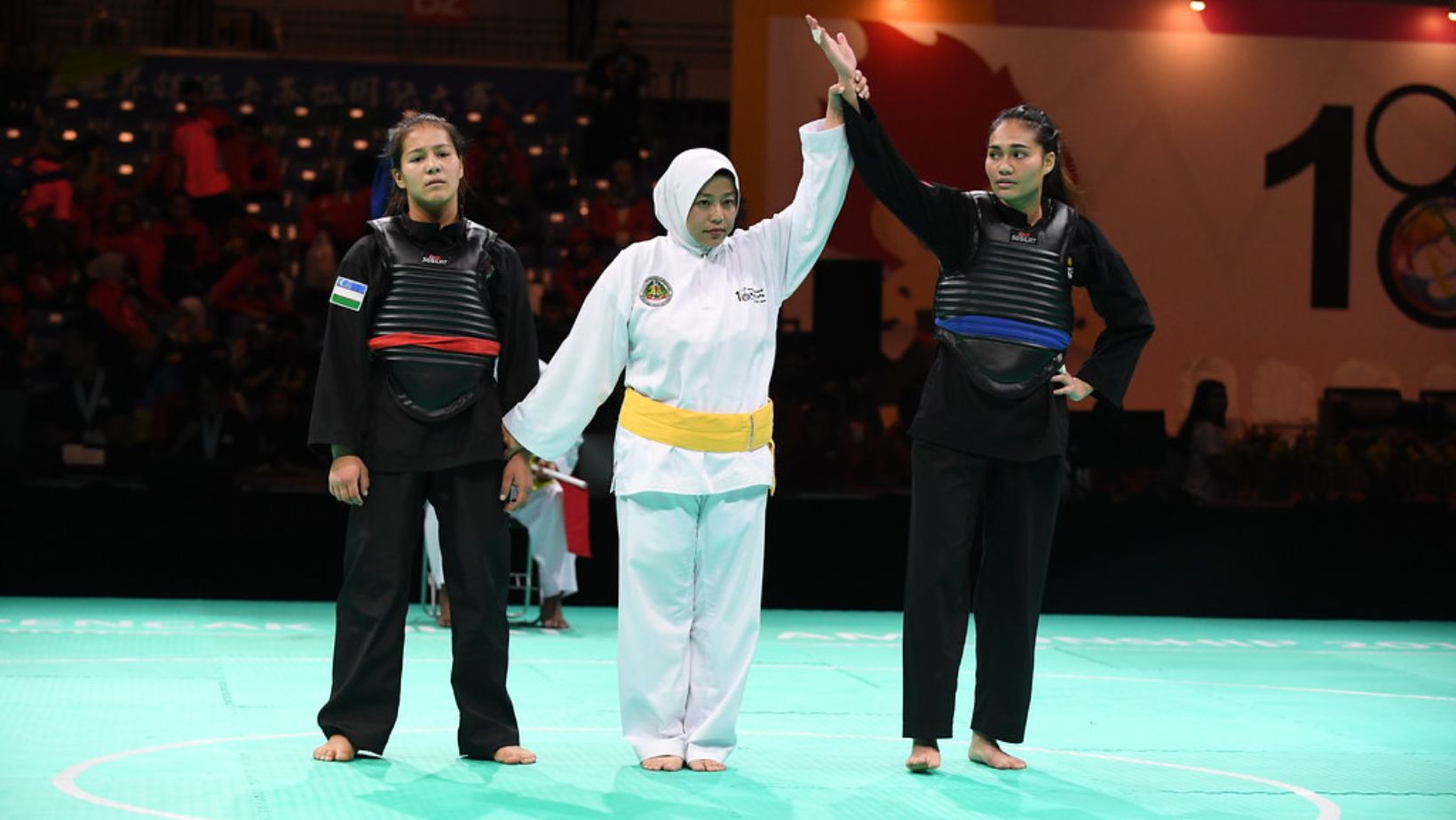
Transitioning from the intricate dynamics of Pencak Silat’s moves and tactics, it’s crucial to delve into the significance of the ‘gelanggang’ or arena in Pencak Silat. Understanding the arena illuminates key factors affecting a fighter’s performance and sheds light on strategic elements of the sport.
The Importance of the Arena in Pencak Silat
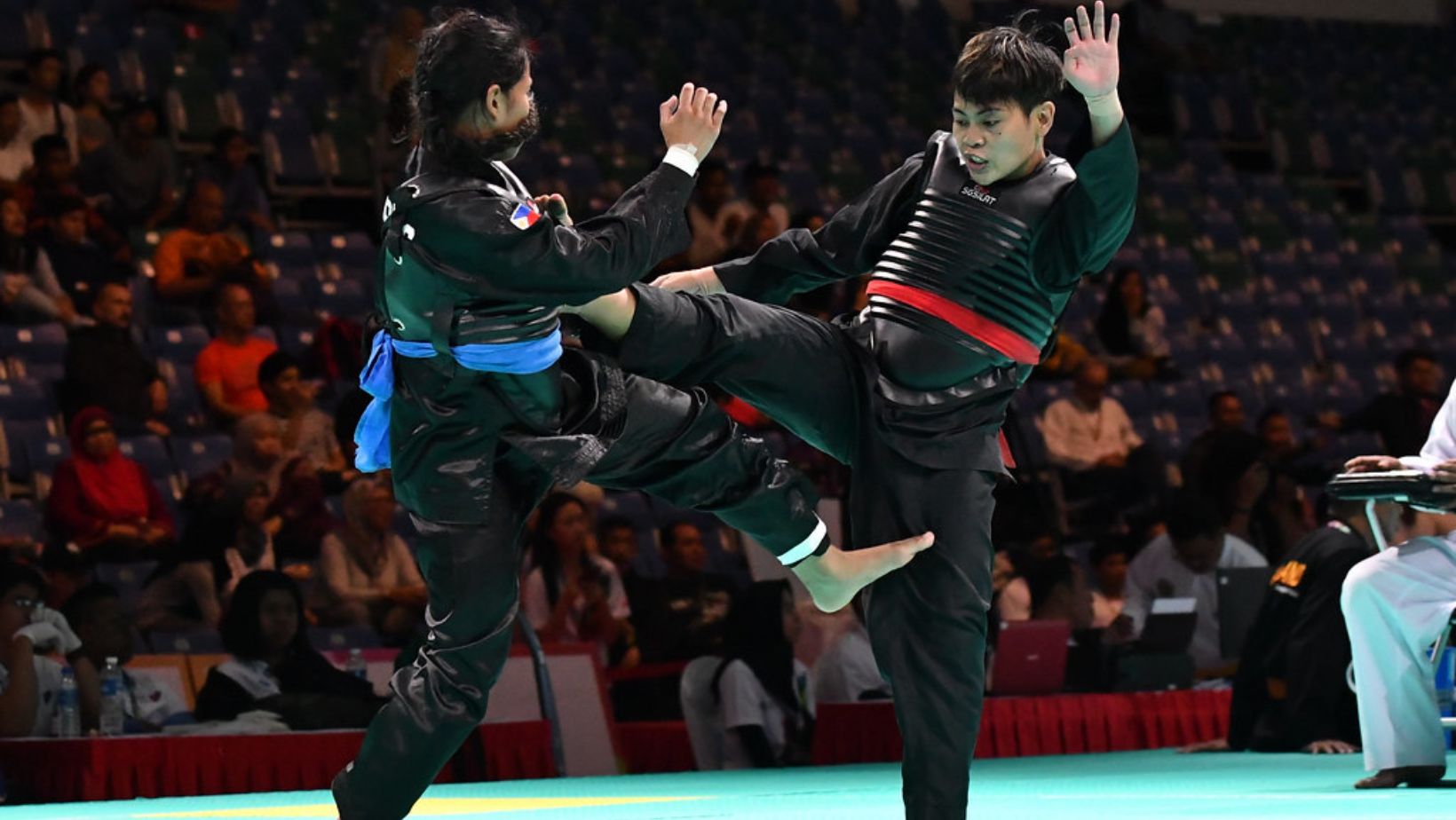 Diving into the significance of the Ukuran Gelanggang Pencak Silat Adalah, it’s evident that its size and layout directly affect the game. It primarily dictates the mobility of competitors. Also, it influences the combat style as fighters can manoeuvre per the arena’s size and dimensions, therefore, adapting their techniques accordingly.
Diving into the significance of the Ukuran Gelanggang Pencak Silat Adalah, it’s evident that its size and layout directly affect the game. It primarily dictates the mobility of competitors. Also, it influences the combat style as fighters can manoeuvre per the arena’s size and dimensions, therefore, adapting their techniques accordingly.
Take, for instance, cornering strategies. In a smaller arena, players often employ close-combat techniques, while in larger arenas, distance management and swift movements become pivotal. This demonstrates how the arena’s specifics intimately manipulate the choice of fighters’ techniques and tactics.
Standard Layout and Specifications of the Arena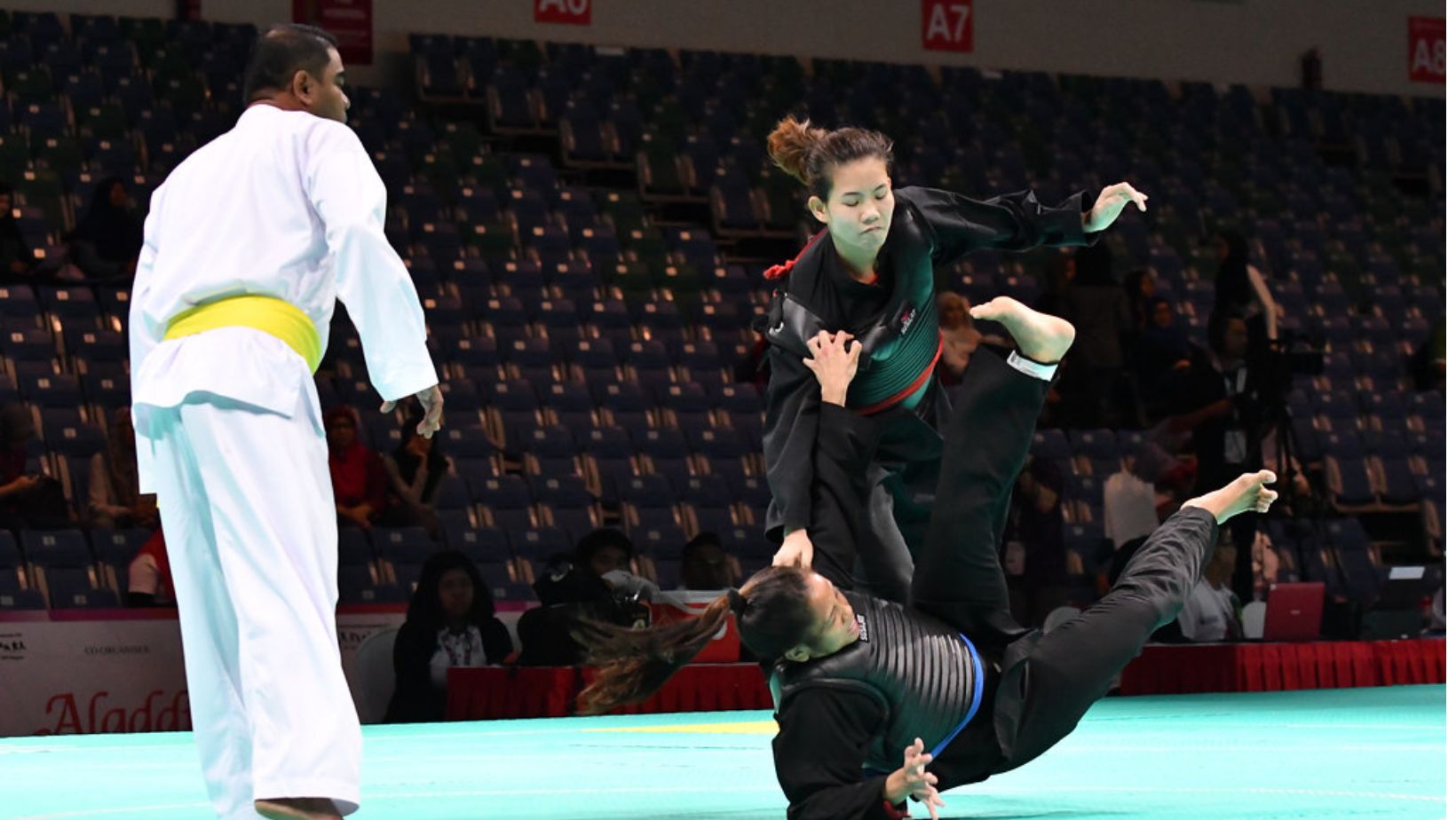
Centring on the standard Pencak Silat arena, it adheres to specific dimensions. Historically, these dimensions have roots in traditional Indonesian culture. It’s typically a square with each side measuring 8 meters, as outlined by the International Pencak Silat Association.
The arena consists of a fight zone demarcated by a border line. This fight zone is 6 x 6 meters, located in the arena’s center. Out-of-play zones, each 1-meter wide, surround this fight zone. Having clear demarcations within the arena aids in maintaining discipline, ensuring fair play, and improving the sport’s overall visibility by setting defined boundaries.
 To illustrate, consider the referees’ perspective. Their primary task involves ascertaining rule adherence, which the arena’s precise layout simplifies. Clear distinction between in-play and out-of-play zones helps them make accurate judgments.
To illustrate, consider the referees’ perspective. Their primary task involves ascertaining rule adherence, which the arena’s precise layout simplifies. Clear distinction between in-play and out-of-play zones helps them make accurate judgments.
This underlines the importance of the arena’s standard layout and specifications not only in enabling fighter strategies but also in promoting a fair, disciplined, and engaging Pancak Silat sport culture.
Ukuran Gelanggang Pencak Silat Adalah: Deep Dive
Building upon prior discussion, the section deep dives into Ukuran Gelanggang Pencak Silat Adalah, a term directly linked to the arena’s size, dimensions, and specifications in Pencak Silat.
Translating Ukuran Gelanggang Pencak Silat Adalah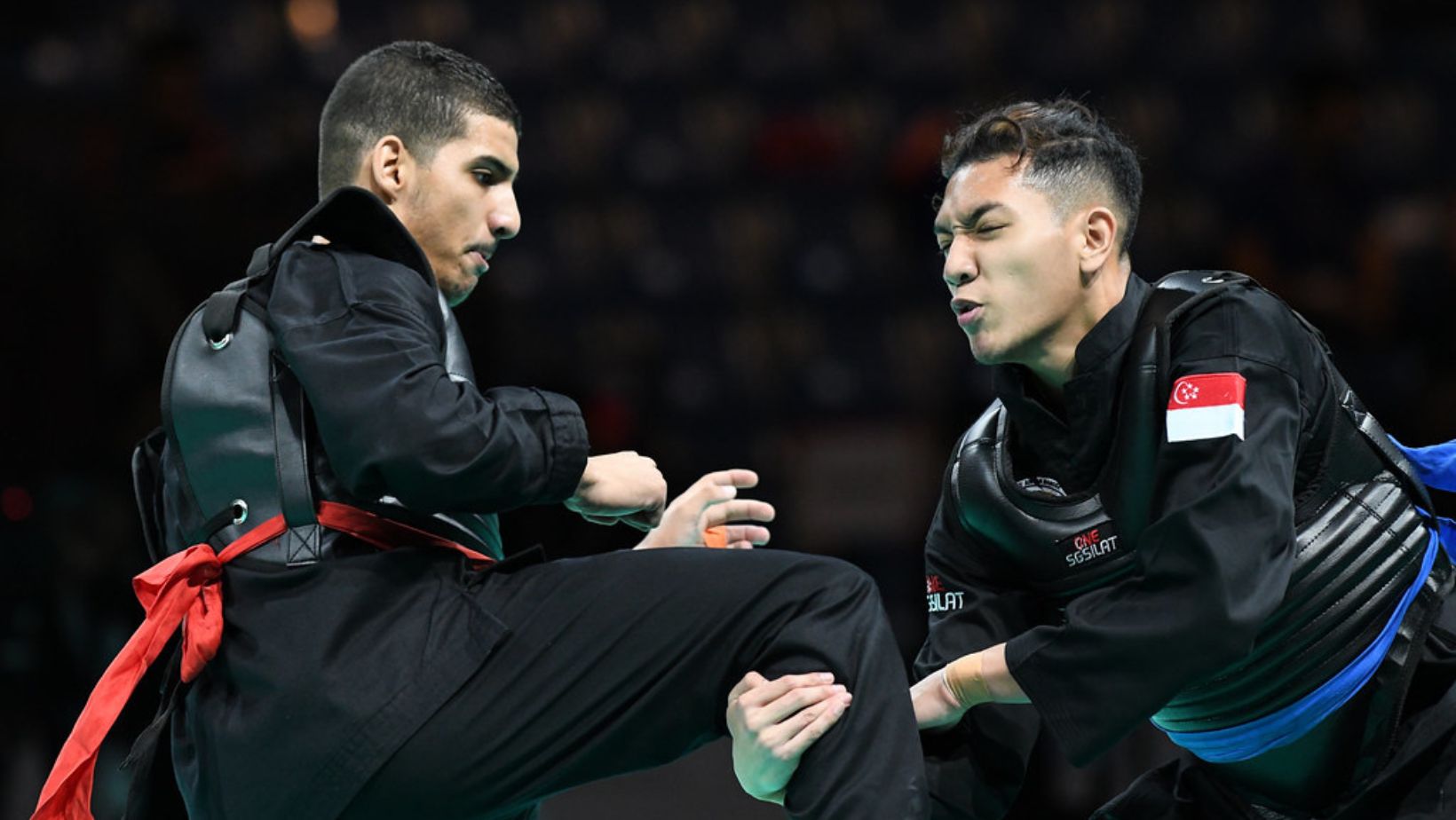
Ukuran Gelanggang Pencak Silat Adalah is an Indonesian phrase, translating in English to ‘the size of the Pencak Silat arena is’. ‘Ukuran’ signifies size, ‘Gelanggang’ denotes arena, ‘Pencak Silat’ is the martial art form, and ‘Adalah’ implies ‘is’. Thus, the term underscores the cruciality of standardized arena dimensions in Pencak Silat matches.
Standard Measurements: Length, Width, and Boundary Lines
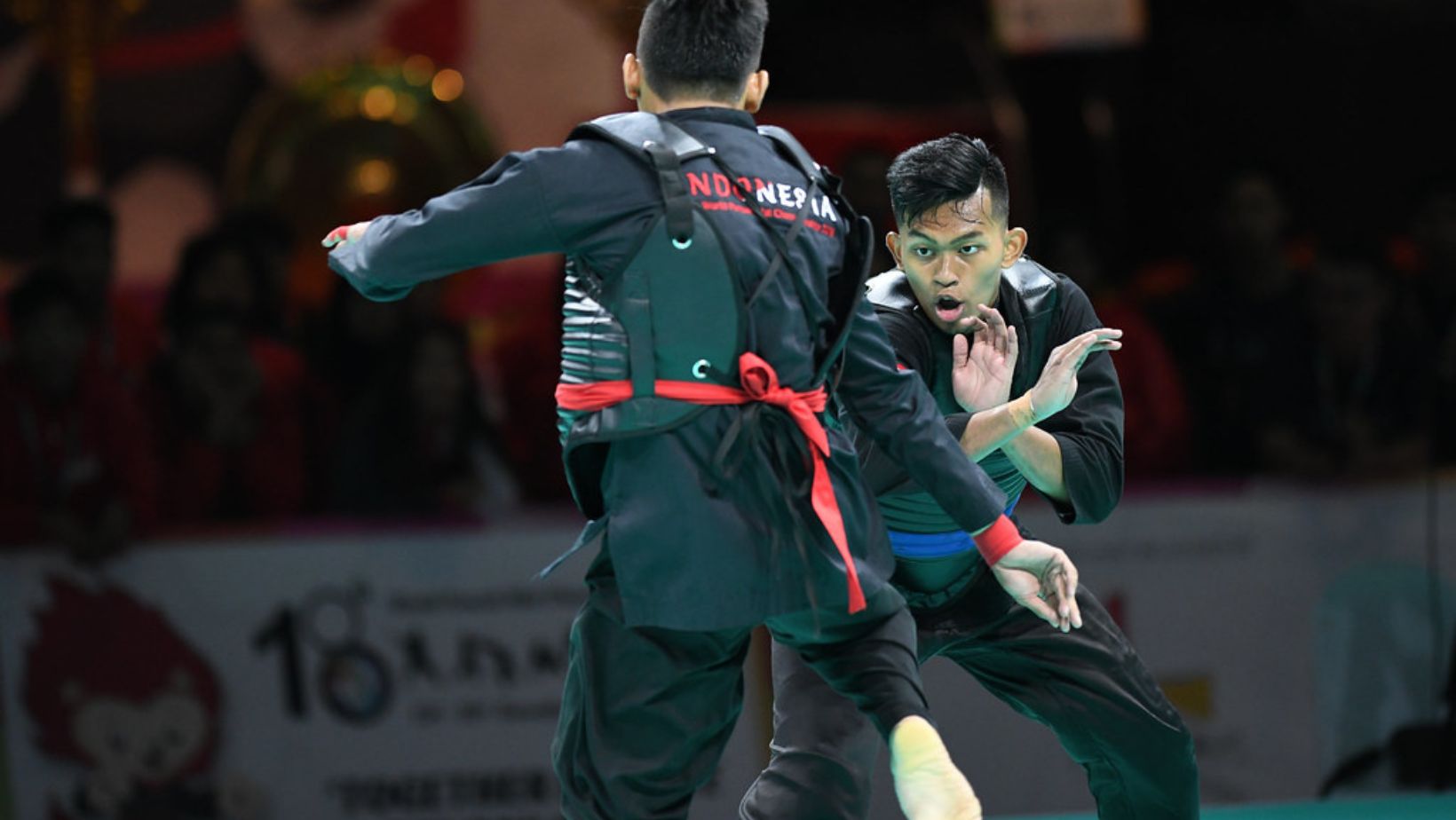 The dimensional parameters of a Pencak Silat arena follow strict guidelines. Regulations state the fighting area must be a square mat with sides measuring 8 meters, surrounded by a safety area of 1 meter wide on every side. Therefore, the total mat area, including the safety area, measures 10 meters on each side. Boundary lines, 4 centimeters wide, separate the fighting and safety areas, effectively communicating the limits of the fighting space to competitors and referees.
The dimensional parameters of a Pencak Silat arena follow strict guidelines. Regulations state the fighting area must be a square mat with sides measuring 8 meters, surrounded by a safety area of 1 meter wide on every side. Therefore, the total mat area, including the safety area, measures 10 meters on each side. Boundary lines, 4 centimeters wide, separate the fighting and safety areas, effectively communicating the limits of the fighting space to competitors and referees.
Significance of the Arena Measurements in the Game
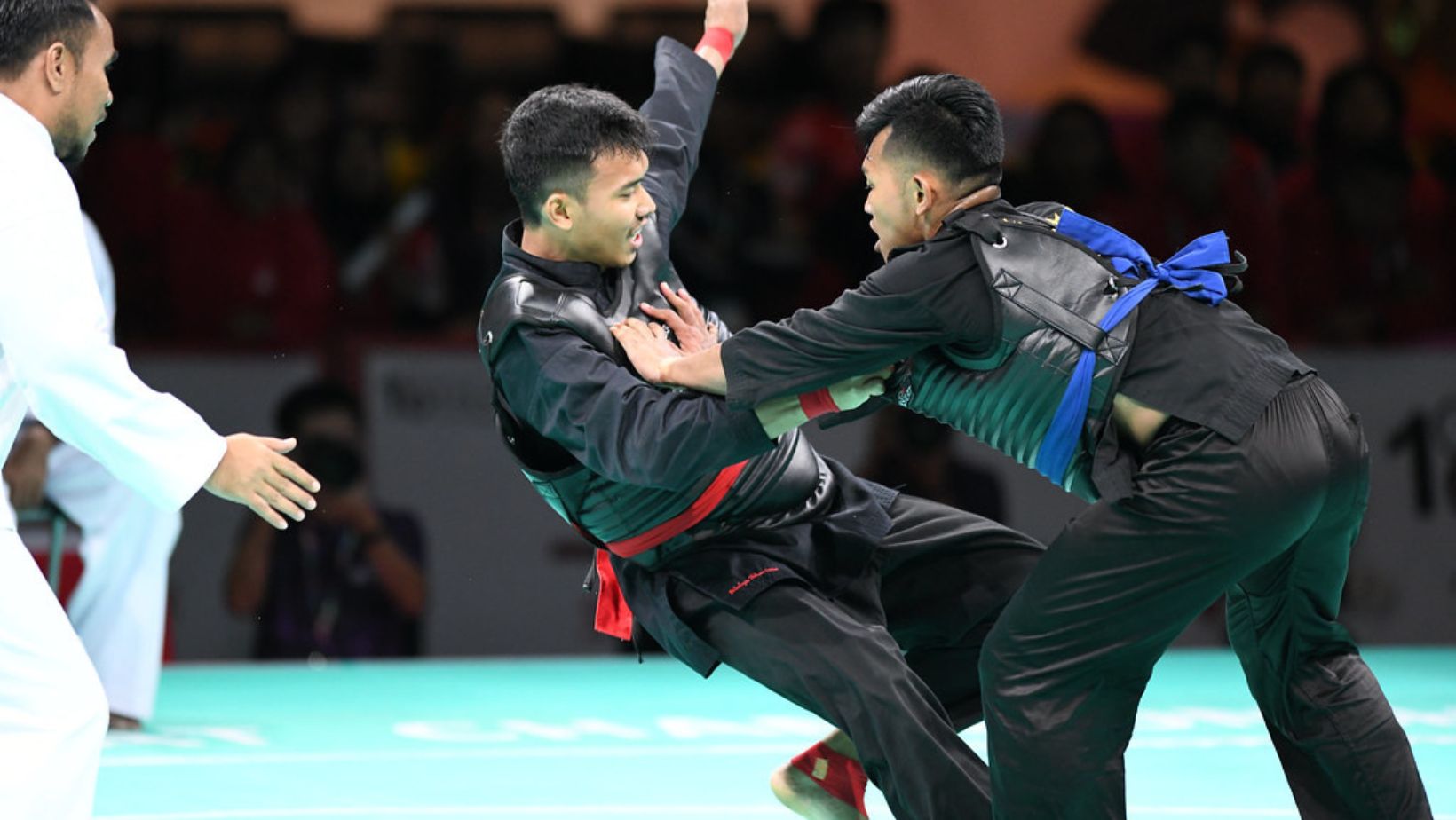 Specific dimensions of the Pencak Silat arena offer a level playing ground to the practitioners. These measurements induce strategic spatial awareness and skillful maneuvering, crucial for gaining a competitive advantage. In limiting the fighting space, the dimensions foster close-quarter combats, compelling fighters to use calculated moves and avoid wastage of efforts. Fourthly, the boundary lines and the safety area in the design underline the sport’s underlying tenet of safety, preventing possible injuries from leaving the combat area. Ultimately, arena measurements significantly contribute to the distinctive gameplay and safety protocol of the Pencak Silat sport.
Specific dimensions of the Pencak Silat arena offer a level playing ground to the practitioners. These measurements induce strategic spatial awareness and skillful maneuvering, crucial for gaining a competitive advantage. In limiting the fighting space, the dimensions foster close-quarter combats, compelling fighters to use calculated moves and avoid wastage of efforts. Fourthly, the boundary lines and the safety area in the design underline the sport’s underlying tenet of safety, preventing possible injuries from leaving the combat area. Ultimately, arena measurements significantly contribute to the distinctive gameplay and safety protocol of the Pencak Silat sport.
Detailed Analysis of Arena Markings
Continuing from the exploration of the standardized dimensions of the Pencak Silat arena, it’s important to examine the specific markings within the ‘gelanggang’ and their relevance in the sport. These markings, such as the centre circle and quarter circles, as well as the borders and outfield, provide strategic guidelines and constraints for the fighters.
Centre Circle and Quarter Circles: Meaning and Importance
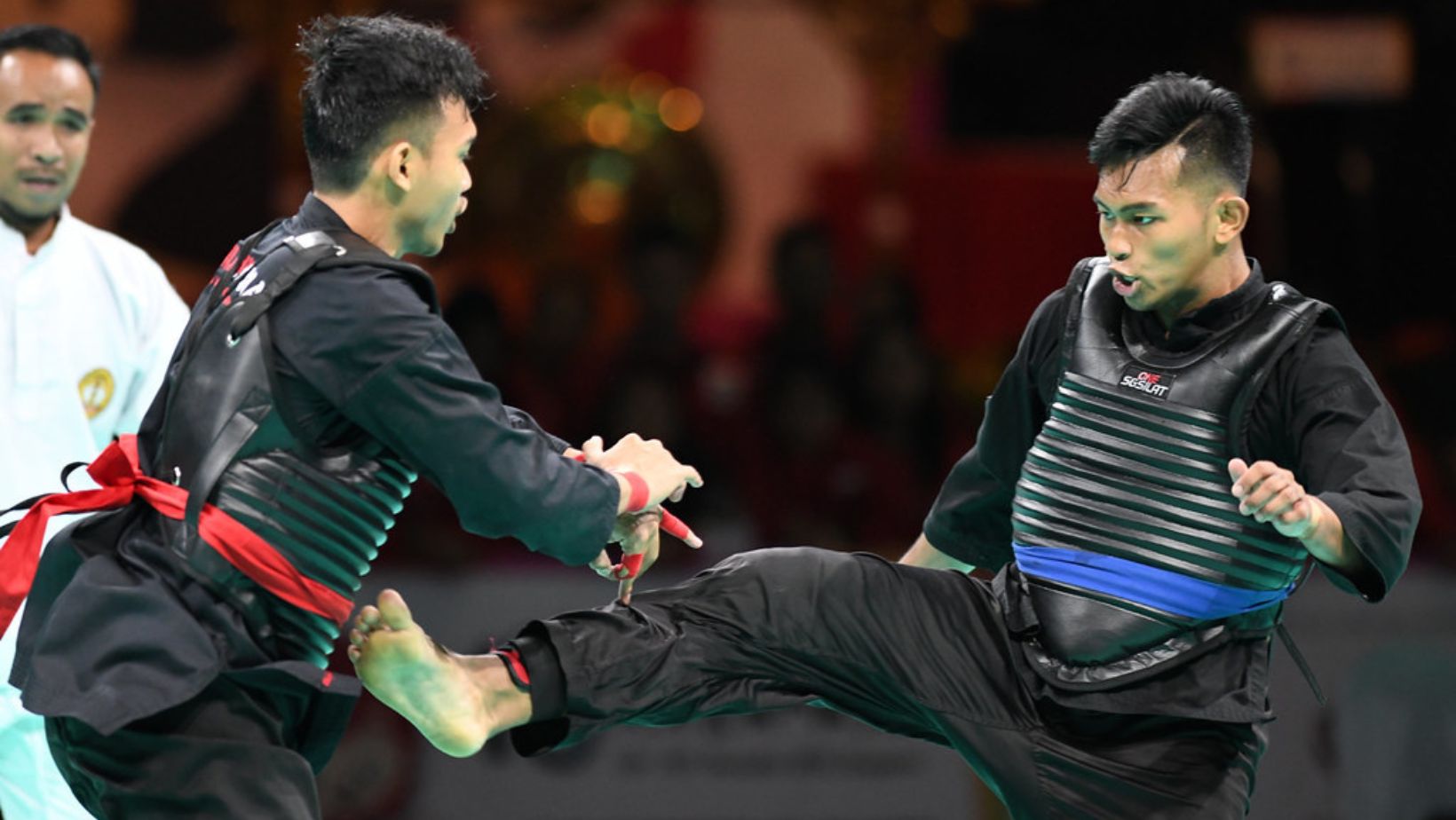 The center of the Pencak Silat arena features a circle with a diameter of 1 meter. This center circle, termed ‘Lingkaran Tengah’, plays a pivotal role in the commencement of every bout, with fighters assuming their starting positions within it.
The center of the Pencak Silat arena features a circle with a diameter of 1 meter. This center circle, termed ‘Lingkaran Tengah’, plays a pivotal role in the commencement of every bout, with fighters assuming their starting positions within it.
Further contributing to the strategic dynamism of the sport are the four quarter circles located at the corners of the arena. These quarter circles, termed ‘Bulatan-Bulatan Sudut’, each have a radius of 1 meter. During the fight, they often serve as tactical focal points, guiding movements and encouraging fighters to showcase their agility and speed.
Borders and Outfield: Constraints and Penalties
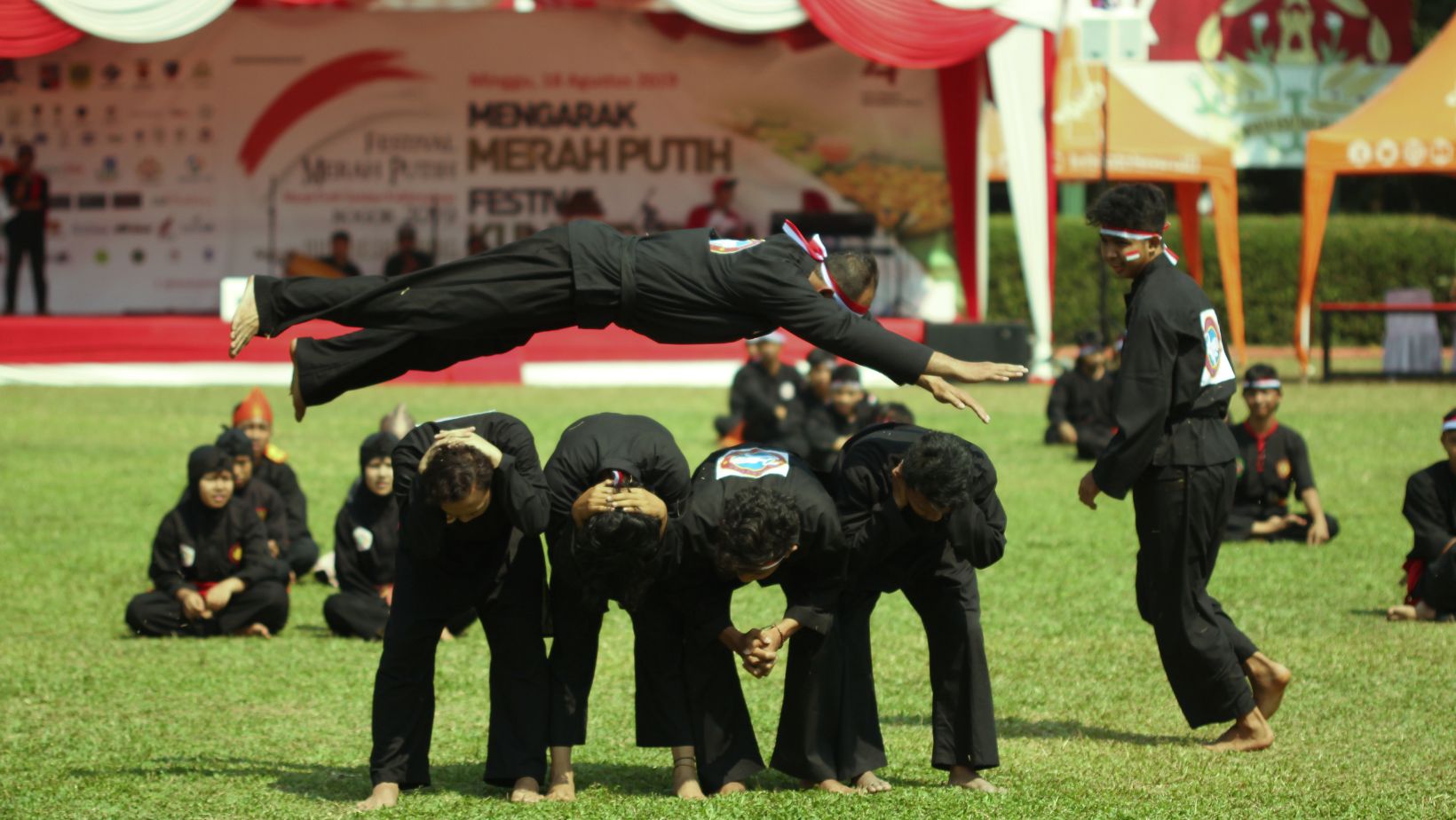 At the periphery of the gelanggang, a 4-meter wide border called ‘Perbatasan Bawah’ demarcates the infield or ‘ring’ where the action takes place from the outfield or ‘tapak luar’. Any movement or action made outside this marked area is typically deemed a violation of the rules, leading to potential penalties.
At the periphery of the gelanggang, a 4-meter wide border called ‘Perbatasan Bawah’ demarcates the infield or ‘ring’ where the action takes place from the outfield or ‘tapak luar’. Any movement or action made outside this marked area is typically deemed a violation of the rules, leading to potential penalties.
It’s paramount for fighters to be mindful of their position relative to these borders during the bout. Straying into the outfield can result in warnings or even disqualification, serving as an added layer of challenge for the fighters. These rules underline the significance of strategic planning and spatial awareness in Pencak Silat, further elevating it beyond a mere display of physical prowess.
Impact of Arena Size on Match Performance
Building on the previous discussion about unique markings and their strategic implications in a Pencak Silat arena, it becomes crucial to delve into how the standard arena size, or ‘Ukuran Gelanggang Pencak Silat Adalah,’ affects match performance. Important areas of influence include changes in fighters’ tactics, strategies, and case studies demonstrating match outcomes shaped by the arena’s dimensions.
Tactics and Strategies Affected by Arena Size
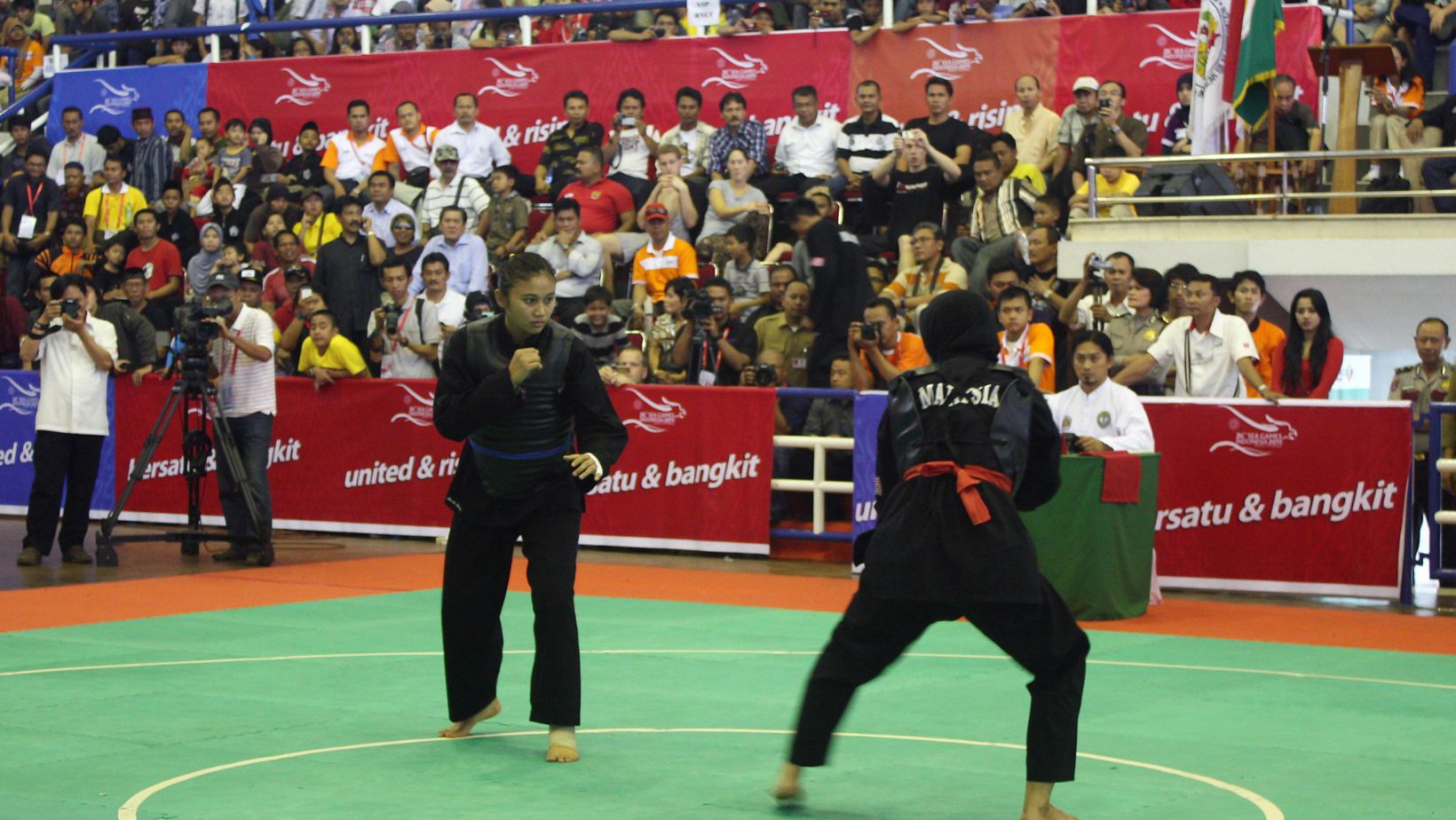 With a square mat of set measurements, a Pencak Silat arena distinctly influences the tactics and strategies employed by the fighters. Factually, it catalyzes quick thinking and acute spatial awareness, encouraging fighters to maximize strategic utilization of the given space. For instance, larger arenas demand longer reach and wider coverage, prompting fighters to modify their offensive techniques to cover greater distances. Conversely, when arenas are smaller, fighters often prioritize defensive, close-quarter combat moves optimized for shorter reach and minimal movement.
With a square mat of set measurements, a Pencak Silat arena distinctly influences the tactics and strategies employed by the fighters. Factually, it catalyzes quick thinking and acute spatial awareness, encouraging fighters to maximize strategic utilization of the given space. For instance, larger arenas demand longer reach and wider coverage, prompting fighters to modify their offensive techniques to cover greater distances. Conversely, when arenas are smaller, fighters often prioritize defensive, close-quarter combat moves optimized for shorter reach and minimal movement.
Embodying the competitive spirit of Pencak Silat, strategic planning becomes a quintessential component for the practitioners operating within these confined dimensions. Achieving victory isn’t just a function of skill but also tactical mastery of the arena. In essence, a fighter’s comprehension of the arena size directly dictates the choice of techniques and the development of personalized fight strategies, thus shortlisting it as a significant determinant of match performance.
Case Studies: How Arena Size Influenced Match Outcomes
 Documented instances further substantiate the role of arena size in deciding match outcomes in Pencak Silat. Let’s examine two exemplary bouts – one in a larger arena, another within a smaller one.
Documented instances further substantiate the role of arena size in deciding match outcomes in Pencak Silat. Let’s examine two exemplary bouts – one in a larger arena, another within a smaller one.
The first case unfolds in a larger arena, where Fighter A and Fighter B faced each other. Both with equally skilled backgrounds, the key differentiator came from Fighter A’s extended familiarity with larger arenas. Fighter A optimized long-range sweeping techniques, consistently keeping Fighter B at bay, orchestrating a controlled match pace, and ultimately emerging victorious.
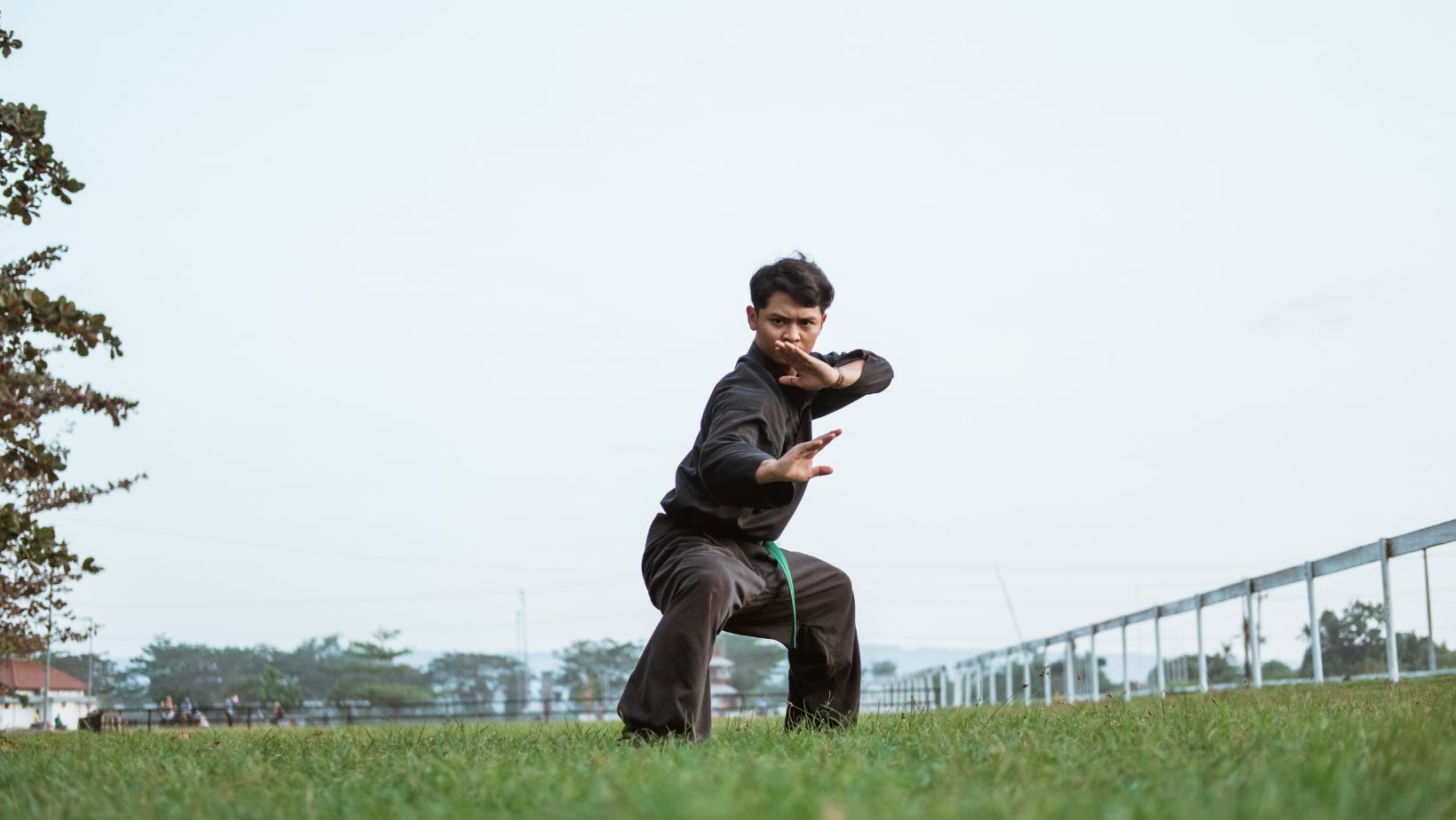 The second bout took place in a smaller arena where Fighter C triumphed over Fighter D. Here, Fighter C excelled in close-quarter combat and capitalized on the limited space by showcasing superior defensive techniques. Fighter C’s agility, combined with spatial intelligence, resulted in an onslaught that eventually overpowered Fighter D.
The second bout took place in a smaller arena where Fighter C triumphed over Fighter D. Here, Fighter C excelled in close-quarter combat and capitalized on the limited space by showcasing superior defensive techniques. Fighter C’s agility, combined with spatial intelligence, resulted in an onslaught that eventually overpowered Fighter D.
Overall, the arena size has proven to play an instrumental role in determining match outcomes, enriching the complex strategic tapestry of Pencak Silat. This evidence demonstrates how deeply intertwined the sport’s intrinsic strategies are with the dynamics facilitated by their standardized arenas, accentuating the competitive allure of Pencak Silat.
Evolution of the Pencak Silat Arena
Changes in Rules and Layout over the Years
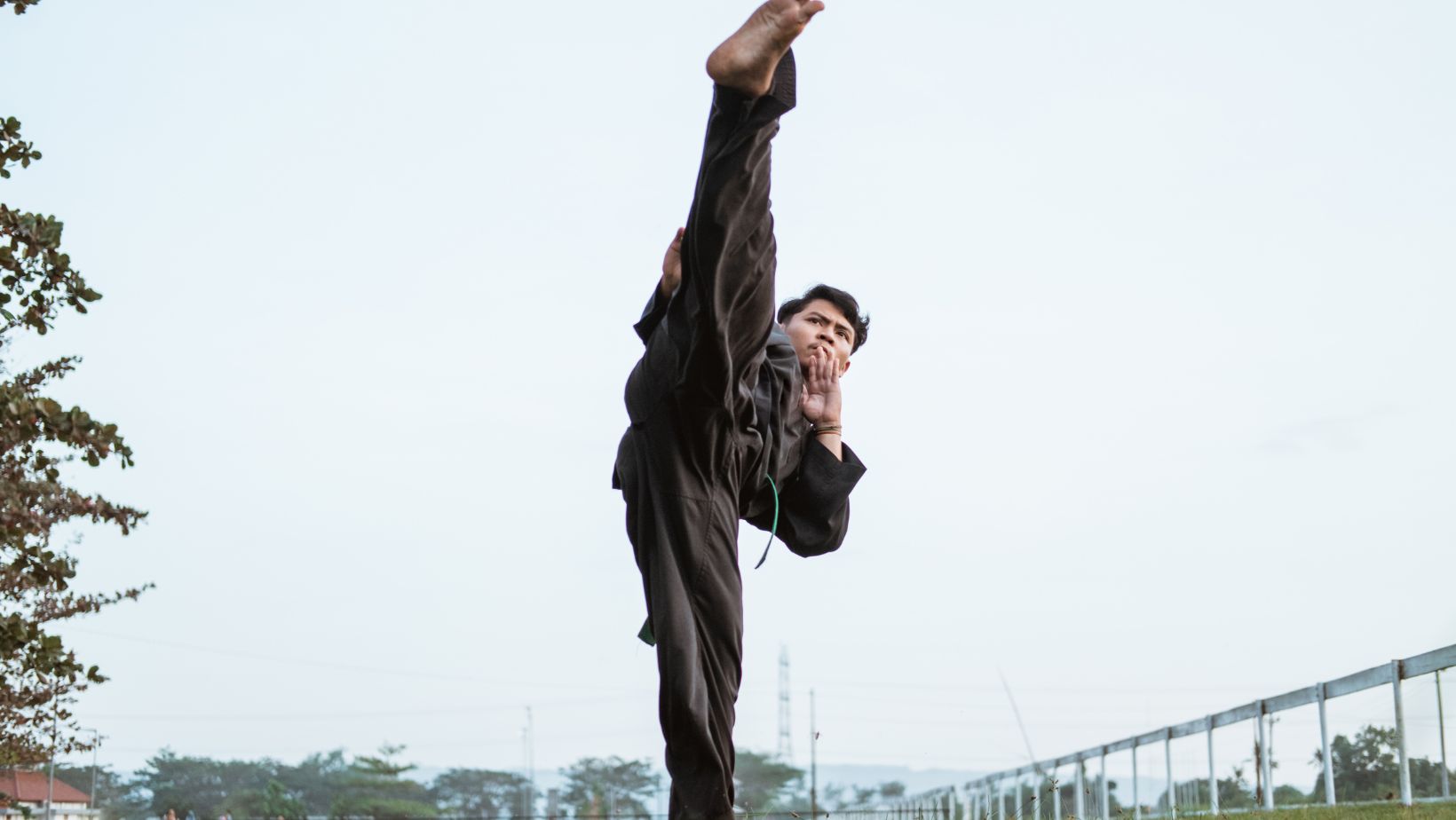 The decades have seen significant transformations to the arena used for Pencak Silat matches. From the early days when matches took place on natural grounds – perhaps a beach or a grassy meadow – to today’s mat-covered floors in well-lit indoor arenas, the journey has been substantial. In the initial years, the field’s size was often inconsistent, stuck to no specific measurements, as one might have gathered from archival texts on early Silat competitions. In the later years, however, the charge of formalization began, bringing about a set of standardized rules and a fixed size for the arena: the ‘Ukuran Gelanggang Pencak Silat Adalah.’
The decades have seen significant transformations to the arena used for Pencak Silat matches. From the early days when matches took place on natural grounds – perhaps a beach or a grassy meadow – to today’s mat-covered floors in well-lit indoor arenas, the journey has been substantial. In the initial years, the field’s size was often inconsistent, stuck to no specific measurements, as one might have gathered from archival texts on early Silat competitions. In the later years, however, the charge of formalization began, bringing about a set of standardized rules and a fixed size for the arena: the ‘Ukuran Gelanggang Pencak Silat Adalah.’
For instance, the official arena size has been stated in the revised Pencak Silat competition rules book, published in 2019, as a mat of 10m x 10m square for senior categories and 8m x 8m square for junior categories. There’s also an extra 1-meter safety margin around the mat. Moreover, the field’s markings – lines showing circles, quadrants, and start lines – followed weaving patterns established in the traditional Indonesian textile art, akin to the batik designs.
Impact of Modern Tech on Arena Designs
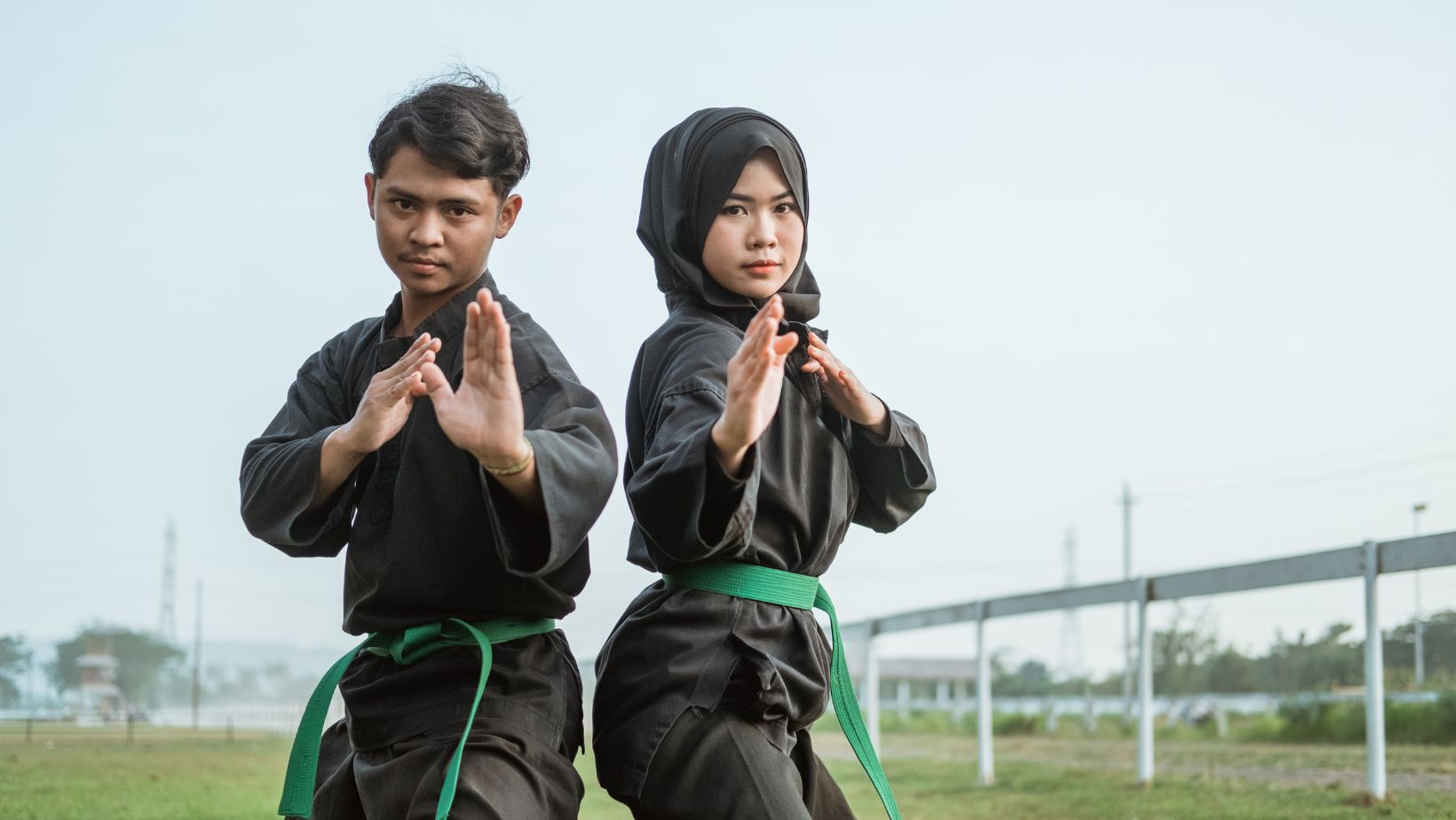 The advent of modern technology has influenced various aspects of Pencak Silat, including the design and construction of the arena. The development of resilient, anti-slip mats has increased fighters’ safety, minimizing the chances of slipping during a match. Electronic scoring systems, installed at vantage points encompassing the arena, provide accurate and objective scorings, eliminating potential bias and human error. These advancements have further elevated the strategic complexity of the sport, allowing fighters to focus on skill and strategy, rather than worrying about inconsistencies in scoring or terrain.
The advent of modern technology has influenced various aspects of Pencak Silat, including the design and construction of the arena. The development of resilient, anti-slip mats has increased fighters’ safety, minimizing the chances of slipping during a match. Electronic scoring systems, installed at vantage points encompassing the arena, provide accurate and objective scorings, eliminating potential bias and human error. These advancements have further elevated the strategic complexity of the sport, allowing fighters to focus on skill and strategy, rather than worrying about inconsistencies in scoring or terrain.
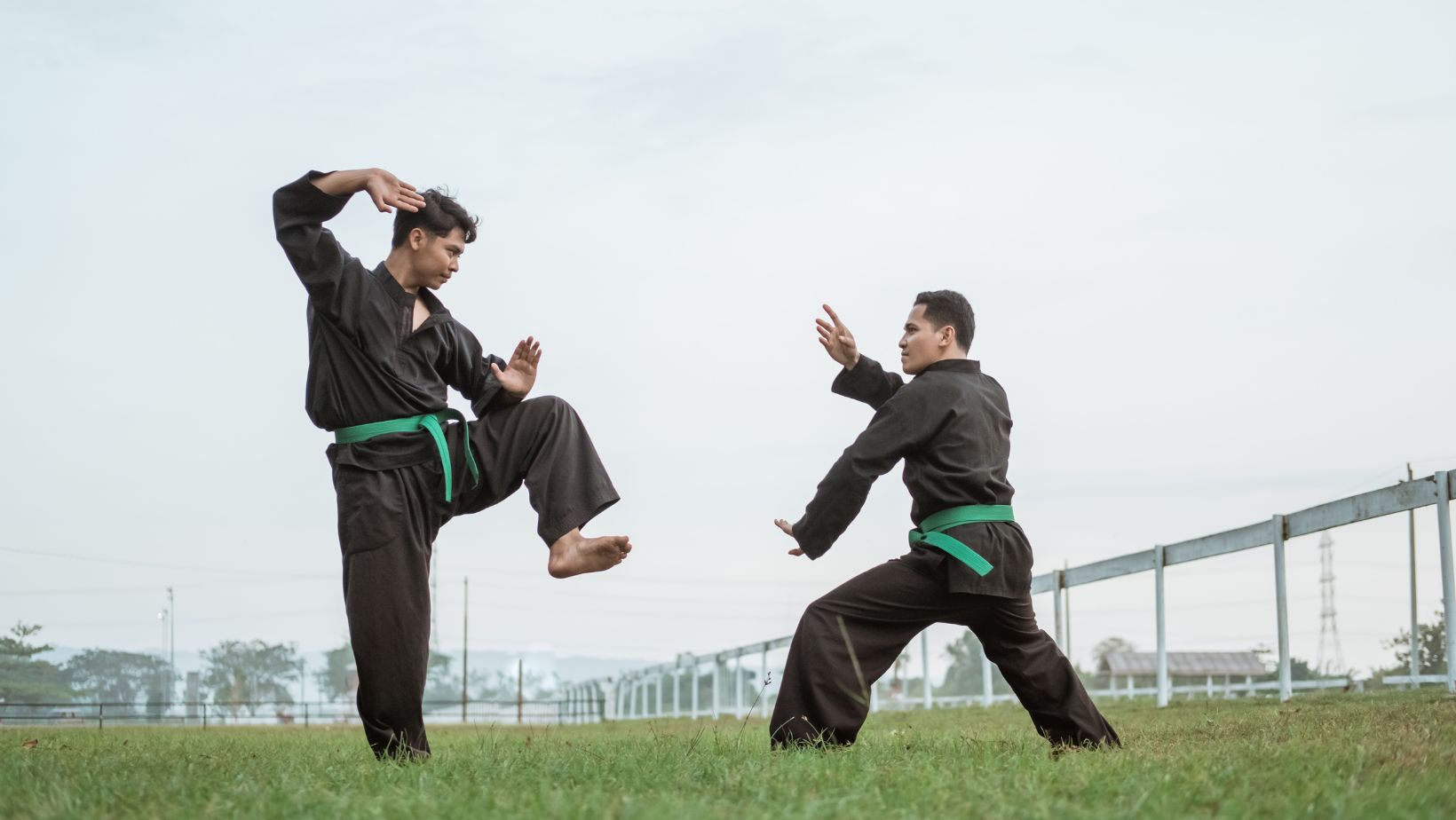 Additionally, the introduction of LED lights has ensured well-lit arenas, enhancing visibility and making Silat matches more spectator-friendly. High-definition broadcast technology even lets global audiences remotely watch matches in real-time. Indeed, the marriage of tradition and technology within the Pencak Silat arena exemplifies how a sport can evolve while staying true to its roots. These transformations not only uphold the sport’s ancient values and philosophies but also demonstrate its adaptability, enhancing its sustainability and appeal in the modern world.
Additionally, the introduction of LED lights has ensured well-lit arenas, enhancing visibility and making Silat matches more spectator-friendly. High-definition broadcast technology even lets global audiences remotely watch matches in real-time. Indeed, the marriage of tradition and technology within the Pencak Silat arena exemplifies how a sport can evolve while staying true to its roots. These transformations not only uphold the sport’s ancient values and philosophies but also demonstrate its adaptability, enhancing its sustainability and appeal in the modern world.
Must Know About Ukuran Gelanggang Pencak Silat Adalah
 It’s clear that the Pencak Silat arena has grown from humble beginnings to a modern, spectator-friendly sport. The shift from natural grounds to standardized, mat-covered floors reflects a dedication to safety and gameplay improvement. It’s the adoption of modern technology like anti-slip mats and electronic scoring systems that has truly revolutionized the sport, creating a fair and strategic environment for fighters. The use of LED lights and high-definition broadcast technology has not only made Silat matches more accessible globally but also preserved the sport’s cultural essence. So, the Pencak Silat arena, in its current form, is a testament to the sport’s evolution – a perfect blend of tradition and modernity. The arena’s transformation is indeed a reflection of the sport’s growing global appeal and its commitment to maintaining its unique cultural identity.
It’s clear that the Pencak Silat arena has grown from humble beginnings to a modern, spectator-friendly sport. The shift from natural grounds to standardized, mat-covered floors reflects a dedication to safety and gameplay improvement. It’s the adoption of modern technology like anti-slip mats and electronic scoring systems that has truly revolutionized the sport, creating a fair and strategic environment for fighters. The use of LED lights and high-definition broadcast technology has not only made Silat matches more accessible globally but also preserved the sport’s cultural essence. So, the Pencak Silat arena, in its current form, is a testament to the sport’s evolution – a perfect blend of tradition and modernity. The arena’s transformation is indeed a reflection of the sport’s growing global appeal and its commitment to maintaining its unique cultural identity.

